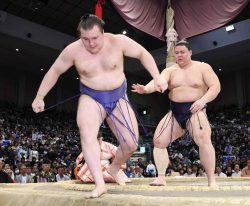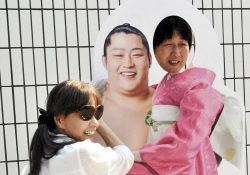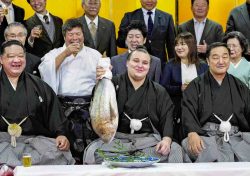
Shirtless sumo wrestling candidates undergo physical checks in Osaka in February 2020.
2:00 JST, November 19, 2023
The Japan Sumo Association, which holds physical examinations prior to all six of its regular tournaments, lowered the basic entry-level standards for new recruits to enter the sport, getting rid of the measurement requirements that keep some from getting a foot in the door.
Behind the backdrop of a national sport that faces an obvious crises of a dwindling number of wrestlers, the move is a reaction to something that could lead to a decline in rikishi over time.
The physical examinations themselves appear to be the same as they were before, with shirtless candidates stepping onto scales.
In what is a kind of feature of the March season, the Spring basho has gained more attention from the media as a sort of employment recruitment event, with those who have finished junior high joining high school graduates as candidates.
These physical checks have experienced issues such as would-be wrestlers chugging down water to add extra body weight, or going to the lengths that former komusubi Mainoumi did when he had silicone embedded in his head to “increase” his height and make the grade.
The physical requirements for candidates were at least 167 centimeters in height and 67 kilograms in weight. For those expected to graduate from junior high school and take the pre-Spring tournament exam, the requirements were 165 centimeters and 65 kilograms. If the requirements were not met, the door would effectively be shut, except for those who had proven to be successful at the amateur level.
At a September board of directors’ meeting, the sumo association agreed to accept wrestlers who were unable to meet the physical requirements but who had been OK’d based on areas such as strength and athletic ability.
Sumo’s reason for having a negative stance toward diminutive wrestlers was because the sport has no weight classes, which that can lead to injuries. However, said one stablemaster: “It’s important to give an opportunity to guys who are motivated.”
What has fired up concern is the continuing decline of the number of aspiring sumo wrestlers. In 1992, there were 223 candidates, sparked by the “Waka-Taka Boom” — the popularity of the wrestling brothers who became yokozuna, Wakanohana and Takanohana. However, last year saw just 66. Other years also saw sharp drops after scandals such as match-fixing. There have been only 53 candidates so far this year, the lowest since the adoption of the six-tournament system.
“In addition to the declining birthrate and a drop in the overall physical strength of children, the competition among sports to attract children is fierce,” said stable master Shibatayama, the former yokozuna Onokuni who is the sumo association director.
Traditional sumo development normally takes candidates right out of junior high school, allowing them to focus on practice without concerns over food or clothing. Recently, however, an increasing number of those with an eye on higher learning continue on to high school and college before transitioning to the professional ranks.
According to data from the All Japan High School Athletic Federation, the number of registered wrestlers in the recent fiscal year was just 763, a fall of more than 200 compared to 10 years ago. There are many wishing to continue their education or find regular jobs, meaning that competition is rising for wrestlers with experience.
As a public interest incorporated foundation, the sumo association’s aim is to have a “path to sumo, which is the national sport, that maintains a level of tradition and discipline that must grow.” But as the number of wrestlers dwindles, many stable masters see “its tradition and future in crisis.”
“We cannot just do nothing and watch everything waste away,” said Shibatayama.
As the coronavirus pandemic has subsided, basho shows have successfully recovered with consecutive days of sellout crowds. However, it won’t matter if the quality and number of wrestlers deteriorates.
The seriousness of the sumo association in looking at the next 10 to 20 years is being tested.
"Sports" POPULAR ARTICLE
-

Speed Skater Yukino Yoshida Clinches Ticket to Milan
-

Yoshinobu Yamamoto Cheered by Los Angeles Lakers Fans at NBA Game
-

Kenta Maeda Joins Rakuten Eagles; Returns from American MLB to Japanese Pro Baseball for First Time Since 2015
-

Ukrainian Sumo Wrestler Sekiwake Aonishiki to be Promoted to Ozeki
-

Maruyama’s Ski Jump Streak Snapped
JN ACCESS RANKING
-

Tokyo Economic Security Forum to Hold Inaugural Meeting Amid Tense Global Environment
-

Keidanren Chairman Yoshinobu Tsutsui Visits Kashiwazaki-Kariwa Nuclear Power Plant; Inspects New Emergency Safety System
-

Imports of Rare Earths from China Facing Delays, May Be Caused by Deterioration of Japan-China Relations
-

University of Tokyo Professor Discusses Japanese Economic Security in Interview Ahead of Forum
-

Japan Pulls out of Vietnam Nuclear Project, Complicating Hanoi’s Power Plans



























